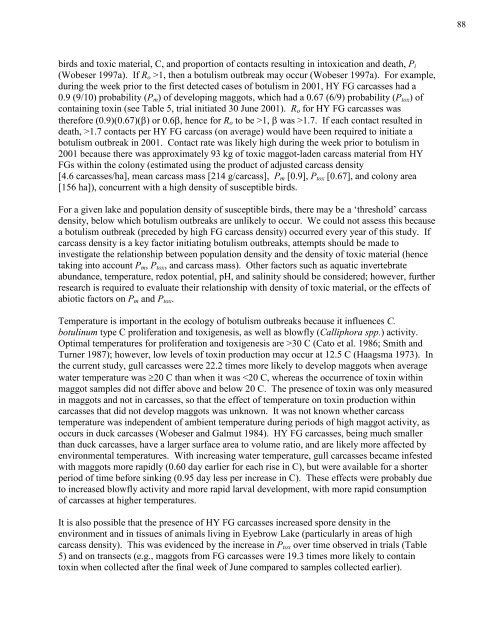Ecology and Management of Avian Botulism on the Canadian Prairies
Ecology and Management of Avian Botulism on the Canadian Prairies
Ecology and Management of Avian Botulism on the Canadian Prairies
Create successful ePaper yourself
Turn your PDF publications into a flip-book with our unique Google optimized e-Paper software.
88birds <str<strong>on</strong>g>and</str<strong>on</strong>g> toxic material, C, <str<strong>on</strong>g>and</str<strong>on</strong>g> proporti<strong>on</strong> <str<strong>on</strong>g>of</str<strong>on</strong>g> c<strong>on</strong>tacts resulting in intoxicati<strong>on</strong> <str<strong>on</strong>g>and</str<strong>on</strong>g> death, P i(Wobeser 1997a). If R o >1, <strong>the</strong>n a botulism outbreak may occur (Wobeser 1997a). For example,during <strong>the</strong> week prior to <strong>the</strong> first detected cases <str<strong>on</strong>g>of</str<strong>on</strong>g> botulism in 2001, HY FG carcasses had a0.9 (9/10) probability (P m ) <str<strong>on</strong>g>of</str<strong>on</strong>g> developing maggots, which had a 0.67 (6/9) probability (P tox ) <str<strong>on</strong>g>of</str<strong>on</strong>g>c<strong>on</strong>taining toxin (see Table 5, trial initiated 30 June 2001). R o for HY FG carcasses was<strong>the</strong>refore (0.9)(0.67)(β) or 0.6β, hence for R o to be >1, β was >1.7. If each c<strong>on</strong>tact resulted indeath, >1.7 c<strong>on</strong>tacts per HY FG carcass (<strong>on</strong> average) would have been required to initiate abotulism outbreak in 2001. C<strong>on</strong>tact rate was likely high during <strong>the</strong> week prior to botulism in2001 because <strong>the</strong>re was approximately 93 kg <str<strong>on</strong>g>of</str<strong>on</strong>g> toxic maggot-laden carcass material from HYFGs within <strong>the</strong> col<strong>on</strong>y (estimated using <strong>the</strong> product <str<strong>on</strong>g>of</str<strong>on</strong>g> adjusted carcass density[4.6 carcasses/ha], mean carcass mass [214 g/carcass], P m [0.9], P tox [0.67], <str<strong>on</strong>g>and</str<strong>on</strong>g> col<strong>on</strong>y area[156 ha]), c<strong>on</strong>current with a high density <str<strong>on</strong>g>of</str<strong>on</strong>g> susceptible birds.For a given lake <str<strong>on</strong>g>and</str<strong>on</strong>g> populati<strong>on</strong> density <str<strong>on</strong>g>of</str<strong>on</strong>g> susceptible birds, <strong>the</strong>re may be a ‘threshold’ carcassdensity, below which botulism outbreaks are unlikely to occur. We could not assess this becausea botulism outbreak (preceded by high FG carcass density) occurred every year <str<strong>on</strong>g>of</str<strong>on</strong>g> this study. Ifcarcass density is a key factor initiating botulism outbreaks, attempts should be made toinvestigate <strong>the</strong> relati<strong>on</strong>ship between populati<strong>on</strong> density <str<strong>on</strong>g>and</str<strong>on</strong>g> <strong>the</strong> density <str<strong>on</strong>g>of</str<strong>on</strong>g> toxic material (hencetaking into account P m , P tox , <str<strong>on</strong>g>and</str<strong>on</strong>g> carcass mass). O<strong>the</strong>r factors such as aquatic invertebrateabundance, temperature, redox potential, pH, <str<strong>on</strong>g>and</str<strong>on</strong>g> salinity should be c<strong>on</strong>sidered; however, fur<strong>the</strong>rresearch is required to evaluate <strong>the</strong>ir relati<strong>on</strong>ship with density <str<strong>on</strong>g>of</str<strong>on</strong>g> toxic material, or <strong>the</strong> effects <str<strong>on</strong>g>of</str<strong>on</strong>g>abiotic factors <strong>on</strong> P m <str<strong>on</strong>g>and</str<strong>on</strong>g> P tox .Temperature is important in <strong>the</strong> ecology <str<strong>on</strong>g>of</str<strong>on</strong>g> botulism outbreaks because it influences C.botulinum type C proliferati<strong>on</strong> <str<strong>on</strong>g>and</str<strong>on</strong>g> toxigenesis, as well as blowfly (Calliphora spp.) activity.Optimal temperatures for proliferati<strong>on</strong> <str<strong>on</strong>g>and</str<strong>on</strong>g> toxigenesis are >30 C (Cato et al. 1986; Smith <str<strong>on</strong>g>and</str<strong>on</strong>g>Turner 1987); however, low levels <str<strong>on</strong>g>of</str<strong>on</strong>g> toxin producti<strong>on</strong> may occur at 12.5 C (Haagsma 1973). In<strong>the</strong> current study, gull carcasses were 22.2 times more likely to develop maggots when averagewater temperature was ≥20 C than when it was


